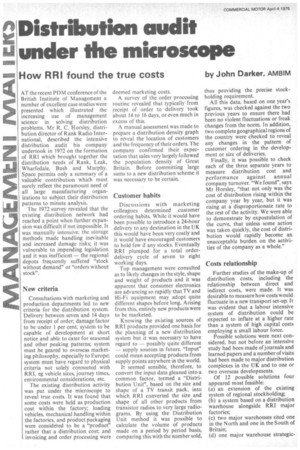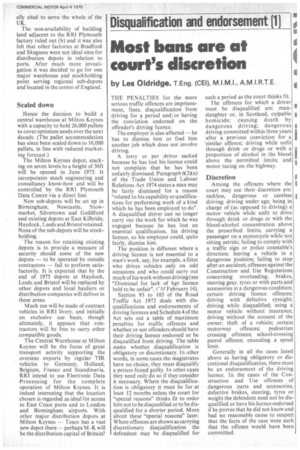Distribution audit under the microscope
Page 50

Page 51

If you've noticed an error in this article please click here to report it so we can fix it.
How RRI found the true costs
by John Darker, AMBIM
AT the recent PDM conference of the British Institute of Management a number of excellent case studies were presented which illustrated the increasing use of management science in solving distribution problems. Mr R. C. Horsley, distribution director of Rank Radio International, described the intensive distribution audit his company undertook in 1972 on the formation of RRI which brought together the distribution needs of Rank, Leak, ' Wharfedale, Bush and Murphy. Space permits only a summary of a valuable contribution which must surely reflect the paramount need of all large manufacturing organizations to subject their distribution patterns to minute analysis.
The 1972 survey revealed that the existing distribution network had reached a point when further expansion was difficult if not impossible. It was manually intensive; the storage methods made handling inevitable and increased damage risks; it was vulnerable to impending legislation and it was inefficient — the regional depots frequently suffered "stock without demand" or "orders without stock".
New criteria
Consultations with marketing and production departments led to new criteria for the distribution system. Delivery between seven and 14 days from receipt of order; damage factor to be under 1 per cent; system to be capable of development at short notice and able to cater for seasonal and other peaking patterns; system must be geared to overseas marketing philosophy, especially to Europe; system must have regard to physical criteria not solely connected with RRI, eg vehicle sizes, journey times, environmental considerations, etc.
The existing distribution activity was put under the microscope to reveal true costs. It was found that some costs were held as production cost within the factory; loading vehicles, mechanical handling within the factories, and product packaging were considdred to be a "product" rather that a distribution cost; and invoicing and order processing were deemed marketing costs.
A survey of the order processing routine revealed that typically from receipt of order to delivery took 'about 14 to 16 days, or even much in excess of this.
A manual assessment was made to prepare a distribution density graph to reveal the location of customers and the frequency of their orders. The company confirmed their expectation that sales very largely followed the population density of Great Britain. Before committing large sums to a new distribution scheme it was necessary to be certain.
Customer habits
Discussions with marketing colleagues determined customer ordering habits. While it would have been possible to introduce a 24-hour delivery to any destination in the UK this would have been very costly and it would have encouraged customers to hold few if any stocks. Eventually RRI plumped for a total orderdelivery cycle of seven to eight working days.
Top management were consulted as to likely changes in the style, shape and weight of products and it was apparent that consumer electronics are advancing so rapidly that TV and Hi-Fi equipment may adopt quite different shapes before long. Arising from this, entirely new products were to be marketed.
Knowing the existing sources of RRI products provided one basis for the planning of a new distribution system but it was necessary to have regard to — possibly quite different — supply sources in future. "Input" could mean accepting products from supply points anywhere in the world.
It seemed sensible, therefore, to convert the input data gleaned into a common factor, termed a "Distribution Unit", based on the size and shape of a TV transit pack, into which RRI converted the size and shape of all other products from transistor radios to very large radiograms. By using the Distribution Unit method it was possible to calculate the volume of products made on a period by period basis, comparing this with the number sold, thus providing the precise stockholding requirement.
All this data, based on one year's figures, was checked against the two previous years to ensure there had been no violent fluctuations or freak changes from the norm. In addition, two complete geographical regions of the country were checked to reveal any changes in the pattern of customer ordering in the development or size of deliveries.
Finally, it was possible to check each of the three separate years to measure distribution cost and performance against annual company turnover. "We found", says Mr Horsley, "that not only was the cost of distribution rising within the company year by year, but it was rising at a disproportionate rate to the rest of the activity. We were able to demonstrate by expostulation of the curve, that unless some action was taken quickly, the cost of distribution would rapidly become an unacceptable burden on the activities of the company as a whole."
Costs relationship
Further studies of the make-up of distribution costs, including the relationship between direct and indirect costs, were made. It was desirable to measure how costs would. fluctuate in a new transport set-up. It was evident that a labour intensive system of distribution could be expected to inflate at a higher rate than a system of high capital costs employing a small labour force.
Possible solutions were next considered, but not before an intensive study had been made of journals and learned papers and a number of visits had been made to major distribution complexes in the UK and to one or two overseas developments.
Of 12 possible solutions four appeared most feasible: (a) an extension of the existing system of regional stockholding; (b) a system based on a distribution warehouse alongside RRI major factories; (c) two major warehouses sited one in the North and one in the South of Britain; (d) one major warehouse strategic ally sited to serve the whole of the UK.
The non-availability of building land adjacent to the RRI Plymouth factory ruled out (b) and it was also felt that other factories at Bradford and Skegness were not ideal sites for distribution depots in relation to ports. After much more investigation it was decided to go for one major warehouse and stockholding point serving regional sub-depots and located in the centre of England.
Scaled down
Hence the decision to build a central warehouse at Milton Keynes with a capacity to hold 26,000 pallets to cover optimum needs over the next decade. (The pallet accommodation has since been scaled down to 16,000 pallets, in line with reduced marketing forecast.) The Milton Keynes depot, stacking on seven levels to a height of 36ft will be opened in June 1975. It incorporates much engineering and consultancy know-how and will be controlled by the RRI Plymouth Data Centre via a direct line.
New sub-depots will be set up in Birmingham, Newcastle, Stowmarket, Silvertown and Guildford and existing depots at East Kilbride, Haydock, Leeds and Bristol retained. None of the sub-depots will be stockholding.
The reason for retaining existing depots is to provide a measure of security should some of the new depots — to be operated by outside contractors — fail to perform satisfactorily. It is expected that by the end of 1975 depots at Haydock, Leeds and Bristol will be replaced by other depots and local hauliers or distribution companies will deliver in these areas.
Much use will be made of contract vehicles in RRI livery, and initially on exclusive use basis, though ultimately, it appears that contractors will be free to carry other compatible goods.
The Central Warehouse at Milton Keynes will be the focus of great transport activity supporting the overseas exports by regular TIR vehicles to Germany, Holland, Belgium, France and Scandinavia. RRI intend to use Electronic Data Processing for the complete operation of Milton Keynes. It is indeed interesting that the location chosen is regarded as ideal for access to East Coast ports and to London and Birmingham airports. With other major distribution depots at Milton Keynes — Tesco has a vast new depot there — perhaps M-K will be the distribution capital of Britain?




































































































